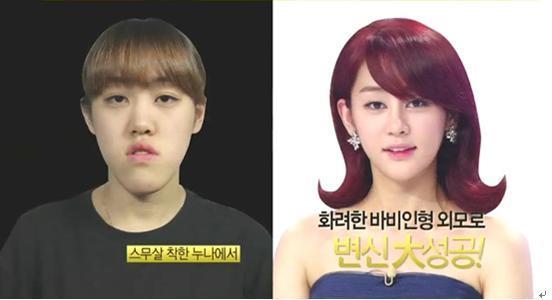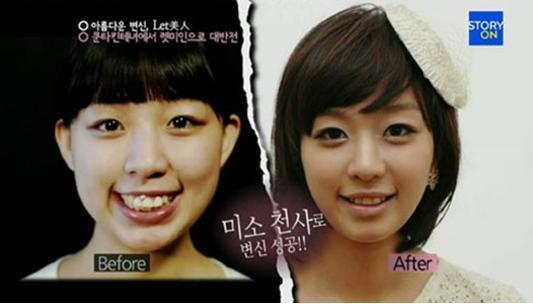과체중과 여유증이 고민이었던 20대 남성과 호르몬 기능 장애로 몸에 털이 과도하게 많은 30대 여성은 모두 새로운 인생을 꿈꾸고 있었다.
그들은 각기 새로운 인생을 찾아 수술대에 누웠고, 새로운 모습으로 세상에 나왔을 때는 모두가 믿을 수 없다는 충격과 함께 그들에게 응원을 보내줬다.
이 장면은 성형 메이크오버쇼 “렛미인”에 나온 장면으로, 렛미인은 2011년에 첫 시즌으로 시작하여 올해 6월 초 세 번째 시즌을 시작했다.
프로그램 제작진에 따르면 프로그램에 대한 인기로 인해 매해 많은 지원자들이 몰렸고 첫 번째 시즌에는 300명, 두 번째 시즌에는 2,000명 그리고 세 번째 시즌에는 4,300명이 몰렸다고 한다.
최근 시즌을 거듭할수록 지원자가 늘어남에 따라 턱을 깎거나 코나 이마에 필러를 주입하는하고자 하는 사람들도 늘어나고 있다. 이들은 전국민이 보는 TV 앞에 서서 그 경험을 다른 사람들에게 기꺼이 보여주고 있다.

그들은 각기 새로운 인생을 찾아 수술대에 누웠고, 새로운 모습으로 세상에 나왔을 때는 모두가 믿을 수 없다는 충격과 함께 그들에게 응원을 보내줬다.
이 장면은 성형 메이크오버쇼 “렛미인”에 나온 장면으로, 렛미인은 2011년에 첫 시즌으로 시작하여 올해 6월 초 세 번째 시즌을 시작했다.
프로그램 제작진에 따르면 프로그램에 대한 인기로 인해 매해 많은 지원자들이 몰렸고 첫 번째 시즌에는 300명, 두 번째 시즌에는 2,000명 그리고 세 번째 시즌에는 4,300명이 몰렸다고 한다.
최근 시즌을 거듭할수록 지원자가 늘어남에 따라 턱을 깎거나 코나 이마에 필러를 주입하는하고자 하는 사람들도 늘어나고 있다. 이들은 전국민이 보는 TV 앞에 서서 그 경험을 다른 사람들에게 기꺼이 보여주고 있다.


그러나 전문가들은 오히려 TV가 사람들을 변화하도록 하고 있다고 말하기도 한다.
“원래 메이크오버 쇼의 유행은 성형대국 등극의 일등 공신이라 할 수 있다. 특히 이 쇼들은 우리 사회 성형 담론의 변화를 주도하며 성형 대중화에 결정적 역할을 했다. 원래 메이크오버 포맷은 어떤 대상을 개선해가는 과정을 다루는 프로그램을 뜻하지만, 국내에선 주로 외모나 스타일을 변신시켜주는 프로그램을 지칭한다. 이 장르는 2003년 동아 TV에서 처음 방영된 <도전, 신데렐라>의 성공 이후 케이블 매체 최고의 효자 콘텐츠로 자리매김했다.” 라고 대중평론가 김선영은 최근 경향신문에 실은 칼럼에서 이렇게 말했다.
몇몇 시청자 의견에 따르면 이 프로그램에서 보여주는 양악 수술 등 위험한 수술을 해 나가는 과정에서 성형수술이 별거 아니라는 의식을 심어 줄 수 있다고 말한다.
턱 뼈를 깎는 양악 수술은 최근 한국 연예인들 사이에서도 크게 유행하고 있고, 또한 양악 수술을 했다고 인정하는 연예인도 많다.
이에 따라 양악 수술보다는 간단한 쌍꺼풀 수술이나 코 수술은 너무 대중화 되어서 중고등학생들까지도 방학 기간 중 쌍꺼풀 수술을 받으러 병원에 오고 있다.
ID 병원에 따르면 2011년부터 2012년까지 내원한 중고등학생이 138퍼센트 증가했으며 2012년부터 올해까지는 37퍼센트 증가했다.
“요즘 쌍꺼풀은 중학교때 해요. 보통 중 3-고1때 많이 사는데 엄마가 기말고사 잘 치면 해준다고 해서 방학때 많이 오고 있습니다.” 라고 병원 관계자가 말했다.
또 다른 성형 트랜드는 남성 성형이 증가하고 있다는 것이다. 남성 환자들은 2011년부터 2012년까지 28 퍼센트가 증가했으며 작년에서 올해까지 14 퍼센트 증가했다. 올해 남성 성형 환자는 ID 병원 전체 환자의 11.8 퍼센트를 차지했다. 한편, 병원은 내부 규정에 따라 정확한 환자 수는 제공하지는 않았다.
한편 미디어 연구는 TV가 시청자들이 보는 세계관에 많은 영향을 미친다고 보고 있다. 그리고 메이크오버 리얼리티 쇼는 사람들이 성형수술을 보는 태도와 미에 대한 인식에도 영향을 미칠 수 있다고 보고 있다.
“연예인들도 (성형했다는 사실을 많이) 밝히고, 약간 여성분들도 예전에는 쟤 성형해서 예뻐졌다는 말이 비난 섞인 말이었다면 (요즘은) 쟤 성형해서 예뻐졌다라는 뉘앙스가 다른말인데 부러워하는 느낌이 든다.” 라고 렛미인의 박민우 PD가 말했다.
박민우 PD는 프로그램이 단순히 외모만 바꿔주는게 아니라 한 사람이 새로운 인생을 살게 해주는 것에 초점을 맞추고 있다고 말하지만, 이에 대한 반대 의견도 많은 것도 사실이다.
렛미인의 제작 의도에 따르면 “육체적, 정신적으로 고통받는 여성들이 콤플렉스를 극복하는 과정”을 그리며, 성형외과, 정신과, 스타일리스트 등 다양한 분야의 전문가들이 힘을 모아 외적 변신뿐만 아니라 내적인 변화를 도모하는 것을 목표로 한다고 말하고 있다.
그러나 반대 의견중에는 이러한 프로그램이 출연자들의 엄청난 변화된 모습을 미화시켜 성형수술에 대한 수요를 증가시키고 있다고 말한다.
그리고 또 몇 몇은 출연자들이 겪고 있는 개인적인 어려움들이 사실은 사회적인 구조문제 때문이라고 말한다.
“하지만 이러한 쇼들의 특징은 역설적으로 모든 삶의 문제를 다시 외모의 문제로 환원하는 결과를 낳는다. 출연자들의 사연 가운데 가족 해체, 가난, 관계의 폭력 등 상당 부분은 사회적 구조적 모순과 관련된 문제들이기 때문이다.” 라고 김선영 대중문화평론가는 말한다. (글/번역: 코리아헤럴드 이우영 기자)
<관련 영어 기사>
Reality shows hype plastic surgery craze
Cosmetic surgery reality TV shows shape public perception and attraction for plastic surgery, beauty
By Lee Woo-young
An overweight 20-year-old man with women‘s breasts and “unattractive facial features,” as well as a 30-year-old woman suffering from excessive hair growth due to a hormonal malfunction boasted that they have found a second life here.
They each went under the knife and were strongly driven to shed weight. And when they walked out into the “world” with vulnerable hearts, hundreds of thousands of people gave them the “victory” sign and applauded them as looking “unbelievably great.”
These were the lucky two picked for the dramatic makeovers depicted in “Let Me In,” a cosmetic surgery makeover reality TV show on cable TV channel StoryOn, which has recently returned for the third season.
According to the production crew, the before-and-after images of the contestants have kept viewers saying tuned and attracted the most applicants since the launch of the program in 2011. The number of applicants increased from 300 for the first season to 2,000 for the second, and to 4,300 for the third. The show “aims to offer physical, psychological and social help to those who are suffering from their appearances” by a panel of specialists that range from plastic surgeons, a dentist, a psychiatrist and stylists.
“It has become harder to select contestants who we can offer help. We have seen severe cases of plastic surgery failures, and even someone with no eye,” said Park Min-woo, executive producer of the show that targets women viewers, at a press conference earlier this month.
And as the number of applicants suggest, more and more people are willing to cut their chin and jaw or inject ”fillers“ in their nose and foreheads to achieve their desire to become ”beautiful“ -- even if being on TV means that the whole country, and possibly the world, will share the experience. Or perhaps, some suggest, it is the other way around -- TV is encouraging people to transform.
“The makeover reality show has been a popular genre on cable TV networks starting with the first cosmetic surgery reality show ’Challenge, Cinderella‘ in 2003. Since then, the makeover shows have played a significant role in driving the cosmetic surgery boom and trend in Korea,” wrote culture critic Lee Sun-young in a recent newspaper column.
According to some viewer comments, the program makes people believe that plastic surgeries are somehow simple in the course of transformation, which feature some risky surgeries such as jawline surgery, which used to be limited to people with dental problems. However, the jawline surgery that cuts a square jawline to create an oval face has become increasingly popular after some celebrities openly admitted to having them. And somewhat simpler surgeries, such as double-eyelid and nose jobs, have become so common that teenage girls drop by at plastic surgeons for procedures during school breaks.
The number of teenage patients at ID Hospital, whose head doctor is a panelist for the “Let Me In,” surged 138 percent from 2011 to 2012 and 37 percent the following year, according to hospital data.
“More teenage girls between 16 and 18 ask their parents for double-eyelid surgery when they make the grades they promised to their parents,” said Jeon Sun-young, director of the hospital’s promotional team.
Another notable trend is that more men choose to go under the knife for aesthetic purposes.
Male patients grew 28 percent from 2011 to 2012 and 14 percent from 2012 to this year at ID Hospital. This year, they make up 11.8 percent of the total patients at the hospital, though the hospital declined to provide actual numbers of plastic surgeries due to internal rules.
According to media studies, the reality show, moreover, shapes people’s attitude towards cosmetic surgery and their perception of beauty.
“Now more women speak openly about their cosmetic surgeries. While women used to refer to someone who had a cosmetic surgery in a disapproving tone, now they give them an envious look,” said the producer Park.
His program vowed that it will focus on making over one’s life instead of just changing their looks, but opponents claim that it drives demand for cosmetic surgery in Korea by beautifying the dramatic transformation of contestants who undergo multiple surgeries.
Some point out the show downplays contestants’ problems to a matter of looks, ignoring overall society or other factors.
“Some contestants experience family separation, poverty, and violence, which are mostly from social structural problems, but the show somehow blames those problems on their looks,” wrote culture critic Kim. (wylee@heraldcorp.com)




![[Herald Interview] 'Amid aging population, Korea to invite more young professionals from overseas'](http://res.heraldm.com/phpwas/restmb_idxmake.php?idx=644&simg=/content/image/2024/04/24/20240424050844_0.jpg&u=20240424200058)












![[KH Explains] Korean shipbuilding stocks rally: Real growth or bubble?](http://res.heraldm.com/phpwas/restmb_idxmake.php?idx=652&simg=/content/image/2024/04/25/20240425050656_0.jpg&u=)

